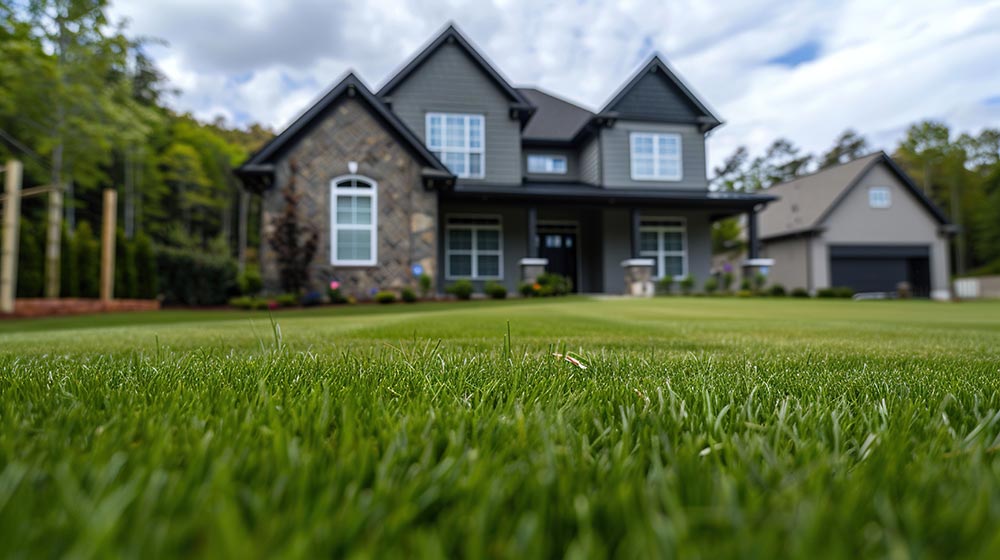B
Blog
Spring Lawn Care: Preparing Your Yard for a Fresh Start After Winter

As the snow melts and the days grow longer, your lawn and garden begin to wake up from their winter slumber. After months of cold temperatures, ice, and snow, your yard needs some attention to regain its lush, healthy appearance. Preparing your lawn for the new season ensures that it thrives throughout the warmer months. Follow these essential steps to bring your yard back to life and inspect your landscaping pavers for any winter damage.
1. Clear Away Debris
Winter leaves behind a mix of fallen branches, dead leaves, and other debris that can suffocate your lawn. Start by raking up leaves and removing any broken branches or clutter from your yard. This allows sunlight and air to reach the soil, promoting healthy grass growth. Be sure to check garden beds and around hardscaped areas where debris might have accumulated.
2. Assess Lawn Health and Repair Damaged Areas
Once the yard is cleared, take a close look at the grass. Snow mold, brown patches, and compacted soil are common problems after winter. If you notice bare spots, consider reseeding them to encourage even grass coverage. Aerating your lawn is also a great way to loosen compacted soil, improve drainage, and allow nutrients to penetrate more effectively.
3. Inspect Your Landscaping Pavers
Winter conditions can be harsh on your landscaping features, particularly pavers used in walkways, patios, and driveways. Freeze-thaw cycles can cause pavers to shift, crack, or become uneven. Take a walk around your property and inspect all pavers for signs of damage. Addressing these issues early will prevent further deterioration and ensure safety. If you notice cracks or misalignment, consider contacting a professional like Groupe Mikasa for repairs to restore your outdoor space.
4. Dethatch and Aerate for Healthy Growth
Thatch is a layer of dead grass and organic matter that builds up on the soil’s surface. If it becomes too thick, it can prevent water and nutrients from reaching the roots. Dethatching helps remove this buildup, allowing your grass to grow more effectively. Lawn aeration is another important step, as it helps alleviate soil compaction and encourages deeper root growth. Both of these processes will improve your lawn’s overall health and resilience.
5. Feed and Fertilize Your Lawn
After a long winter, your lawn needs essential nutrients to regain its strength. Apply a high-quality spring fertilizer to promote new growth and green-up your grass. Look for a balanced fertilizer with nitrogen, phosphorus, and potassium to encourage strong roots and vibrant color. If you prefer a natural approach, compost is an excellent organic alternative that enriches the soil and enhances microbial activity.
6. Tune Up Your Irrigation System
Proper watering is crucial for a thriving lawn, especially in the early spring when new growth begins. Inspect your irrigation system for leaks, broken sprinkler heads, or clogged nozzles. If you rely on manual watering, establish a consistent schedule that provides deep, even hydration to encourage strong root development. Watering early in the morning is ideal, as it minimizes evaporation and reduces the risk of fungal growth.
7. Mow With Care
The first mow of the season is an important one. Set your mower blades to a higher setting to avoid cutting the grass too short, which can stress the lawn. Keep the blades sharp to ensure clean cuts that promote healthy regrowth. Regular mowing throughout the season encourages a thick, lush lawn and helps keep weeds at bay.
8. Apply Weed Control
Weeds can quickly take over if left unchecked. Early spring is an excellent time to apply pre-emergent weed control to prevent weeds like crabgrass from sprouting. If weeds have already appeared, spot-treat them with a targeted herbicide or remove them manually. A well-maintained lawn is naturally more resistant to weed invasion.
9. Prune Trees and Shrubs
Spring is also the perfect time to trim overgrown trees and shrubs. Pruning removes dead or damaged branches, promotes healthy growth, and improves the overall appearance of your landscape. Be mindful of flowering shrubs—prune them after they bloom to avoid cutting off future blossoms.
10. Refresh Mulch and Garden Beds
Mulching your flower beds and garden areas helps retain moisture, regulate soil temperature, and suppress weed growth. Refresh existing mulch by fluffing it up or adding a fresh layer for a polished look. Choose organic mulch options like wood chips or shredded bark to enrich the soil as they break down.
Final Thoughts
Spring is a time of renewal, and your lawn and landscape deserve the same fresh start. By following these essential lawn care steps and inspecting your landscaping pavers for winter damage, you’ll create a beautiful and inviting outdoor space for the season ahead. Regular maintenance and early intervention can prevent costly repairs and keep your property looking its best all year long. So grab your rake, inspect your pavers, and get ready to enjoy a lush, green lawn this spring!
